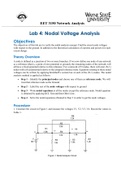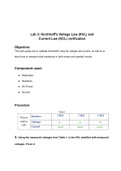Richard c dorf - Study guides, Class notes & Summaries
Looking for the best study guides, study notes and summaries about Richard c dorf? On this page you'll find 54 study documents about Richard c dorf.
Page 4 out of 54 results
Sort by

-
Lab 7: Testing and Analyzing Circuit Using Thévenin and Norton Theorems
- Other • 9 pages • 2023
-
- $14.69
- + learn more
Thévenin’s Theorem for DC circuits states that any two port linear network may be replaced by a single voltage source with an appropriate internal resistance. The Thévenin equivalent will produce the same load current and voltage as the original circuit to any load. Consequently, if many different loads or sub-circuits are under consideration, using a Thévenin equivalent usually proves to be a much quicker method of analysis. Any complex circuit consisting of multiple sources and components...
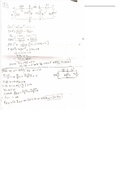
-
Network analysis HW Chapter 4
- Other • 10 pages • 2023
-
- $10.49
- + learn more
This course will cover the topics in electric network analysis and design. Techniques of electric circuit theory are studied and applied in network analysis and design, operational amplifiers, and related circuits, including the applications with NI Multisim, and MATLAB software packages. Analysis of circuits with dependent sources, basic waveforms, RL, RC, and RLC circuit transients and sinusoidal response, network functions, and power analysis
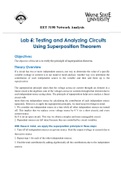
-
Lab 6: Testing and Analyzing Circuits Using Superposition Theorem
- Other • 8 pages • 2023
-
- $14.69
- + learn more
The superposition principle states that the voltage across (or current through) an element in a linear circuit is the algebraic sum of the voltages across (or currents through) that element due to each independent source acting alone. The principle of superposition helps us to analyze a linear circuit with more than one independent source by calculating the contribution of each independent source separately. However, to apply the superposition principle, we must keep two things in mind: 1. We ...
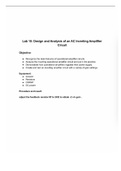
-
Lab:10 Design and Analysis of an AC Inverting Amplifier Circuit
- Other • 8 pages • 2023
-
- $14.69
- + learn more
This course will cover the topics in electric network analysis and design. Techniques of electric circuit theory are studied and applied in network analysis and design, operational amplifiers, and related circuits, including the applications with NI Multisim, and MATLAB software packages. Analysis of circuits with dependent sources, basic waveforms, RL, RC, and RLC circuit transients and sinusoidal response, network functions, and power analysis

-
Energy Storage Chapter 7
- Other • 85 pages • 2023
-
- $9.59
- + learn more
In this docu, we will introduce two new and important passive linear circuit elements: Capacitors Inductors • Unlike resistors, which dissipate energy, capacitors and inductors do not dissipate but store energy, which can be retrieved at a later time. For this reason, capacitors and inductors are called storage elements. • We begin by introducing capacitors and describing how to combine them in series or in parallel. Later, we do the same for inductors. • Also, we will explore ...

-
Lab 12: Testing and Analyzing Capacitors and Inductors circuits
- Other • 9 pages • 2023
-
- $14.69
- + learn more
The goal of this exercise is to familiarize yourself with the fundamental behavior of capacitors and inductors. The goal of this lab is to experiment with and research the transient behavior of capacitors and inductors (charging and recharging capacitor/inductor networks), as well as to look at simple electrical circuits with parallel/series capacitor/inductor combinations. You should be able to examine circuit behavior when DC or AC voltages are applied to these circuits by the end of this lab....
The objectives of this lab are to verify the nodal analysis concept. Find the circuit node voltages with respect to the ground. In addition to the theoretical calculation of currents and powers for each circuit desig
The objectives of this lab are to verify Kirchhoff's laws for voltage and current and to learn how to measure the total resistance of both series and parallel circuits..

-
Lab:11 Design and Analysis of AC Non-Inverting Amplifier and DC Differential Amplifier Circuits
- Other • 7 pages • 2023
-
- $14.69
- + learn more
In this document ▪ Measure the gain and verify the non-inverted output waveform from non-inverting amplifier circuit design. ▪ Design, simulate and test the DC differential amplifier circuit. ▪ Measure the gain and verify the output value of DC differential amplifier circuit design using different resistance values.
Analyze electric circuits using Superposition Theorem Investigate maximum power transfer and load match

Did you know that on average a seller on Stuvia earns $82 per month selling study resources? Hmm, hint, hint. Discover all about earning on Stuvia



